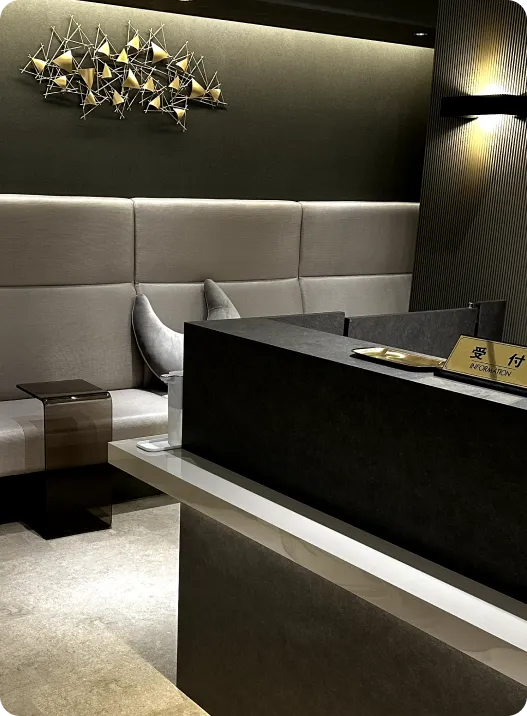Book Appointment
After your inquiry, our staff will schedule your visit and confirm your reservation.
Aging skin undergoes gradual changes due to reduced collagen, elastin, and moisture, leading to fine lines, wrinkles, and loss of firmness. Slower cell turnover and environmental damage contribute to uneven texture and pigmentation. Over time, skin appears thinner and more prone to dryness and sagging.



Our bodies have the natural ability to regenerate and replace lost cells, such as skin and blood cells, to maintain tissues that are short-lived and frequently renewed. Cells with this regenerative capability are known as "stem cells." To qualify as a stem cell, two essential abilities are required: the ability to generate different types of cells that make up our bodies, like skin cells, red blood cells, and platelets (differentiation ability), and the capacity to divide and produce new cells identical to themselves (self-renewal ability).
Stem cells fall into two main categories. One type includes those that continually replace lost cells within specific tissues and organs, such as skin or blood, known as "tissue stem cells." These cells are specialized to perform specific roles, for example, hematopoietic stem cells that generate blood cells belong to the blood system, while neural stem cells that produce the nervous system are restricted to nervous system cells. The other category is "pluripotent stem cells," which can create any type of cell in the body, as seen with embryonic stem (ES) cells.
In summary, pluripotent stem cells have the potential to give rise to various tissue stem cells in our bodies. iPS cells (induced pluripotent stem cells) are a type of pluripotent stem cell that scientists have developed from ordinary cells. Research is advancing into a new therapeutic approach called "regenerative medicine," which uses the properties of stem cells to heal injuries and diseases by utilizing cells themselves as treatment. This research also includes exploring disease mechanisms by replicating the cellular conditions of the body in external environments.

Stem cells are remarkable cells with the ability to replace aged cells and replenish lost ones with new, healthy cells. While we lose the softness of baby-like skin as we age, stem cells—our own “baby cells”—remain present in our bodies. These stem cells have the power to regenerate fresh skin, helping to rejuvenate and revitalize our skin’s appearance.
Injecting cells directly into the skin targets the dermis, the essential layer for maintaining youthful skin. The dermis mainly consists of “fibroblasts” and their source, “mesenchymal stem cells.” These cells produce collagen, elastin, and hyaluronic acid, which are key to skin structure. When the dermis becomes aged or damaged, stem cells home to the damaged tissue, promoting collagen production and initiating repair, effectively rejuvenating the skin.
A license is required to provide regenerative medicine In order to provide regenerative medicine, based on the Act on Ensuring the Safety of Regenerative Medicine, a specific authorized regenerative medicine committee has It must be reviewed by the Ministry of Health, Labor and Welfare and accepted by the Ministry of Health, Labor and Welfare. Artisan Clinic Hibiya is a medical institution that has been accepted by the Ministry of Health, Labor and Welfare for a provision plan for knee joint stem cell administration.



After your inquiry, our staff will schedule your visit and confirm your reservation.

After you complete the questionnaire, the doctor will explain stem cell treatment and recommend a plan suited to your health condition.



Stem cells are harvested from abdominal or buttock fat. 20 grams of adipose (fat) cells are extracted and it can be cultivated into 20 sessions of stem cell therapy. There is only a very small wound of 1 cm to harvest the fat.

We will culture stem cells and exosomes over about 4 weeks. To maintain optimal conditions, please avoid changing or canceling the administration date once scheduled.



Cleanse face → Apply anesthetic tape and cream (20-30 mins) → Inject as requested → Ice area → Apply anti-inflammatory cream and sunscreen.

Before leaving, our staff will provide post-treatment instructions. You may go home the same day, but please avoid driving for safety. Contact us with any concerns, and our team will respond promptly.


No, hospitalization is not required. Stem cells are collected during the first visit, and the administration takes place during the second visit. However, a 4-week cell culture period is needed between collection and administration.

Skin sampling is done under local anesthesia, similar to a dental procedure. The skin collected is about 5 mm, and after a month, it becomes almost unnoticeable you can't even tell where it was taken.

The effectiveness of stem cell therapy can vary significantly between individuals, but a general guideline is that results may be seen within 3 to 6 months.

Stem cells are distributed throughout the body. While adipose (fat) tissue has traditionally been known for its high concentration of stem cells, advancements in cultivation technology now allow for equal or even greater stem cell yields from skin and subcutaneous fat. Recognizing that patients may be hesitant about liposuction, our clinic instead collects stem cells from subcutaneous fat under the skin.

Medical expenses may qualify for a deduction if they are related to treatment. For detailed information on how to proceed, please reach out to your local tax office. Be sure to keep the receipt provided by our clinic for your records.

As it is a specialized medical treatment, the full cost will be covered by the patient, and it is not covered by insurance.










